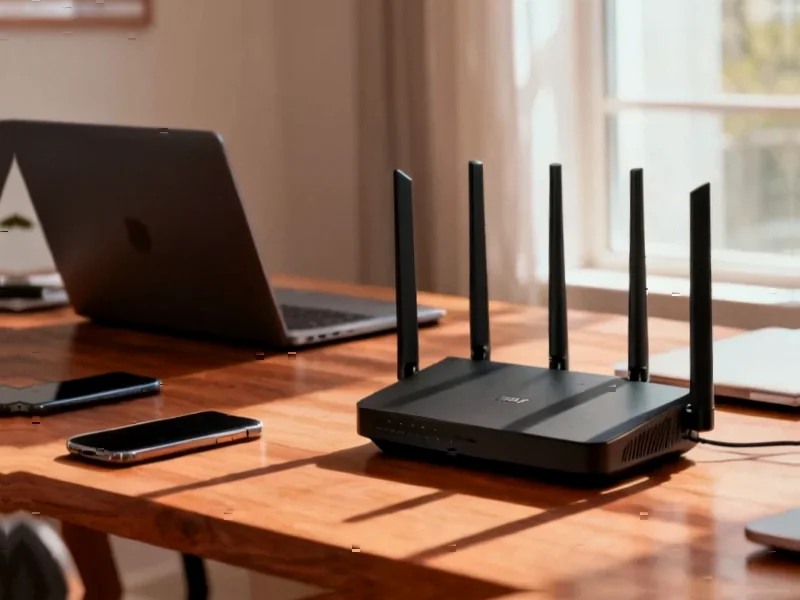According to XDA-Developers, building an enterprise-grade home network doesn’t require expensive “prosumer” or enterprise-level equipment costing hundreds to thousands of dollars. The publication emphasizes strategic planning using affordable components like $100 mini PCs running open-source router software, sub-$200 UPS units for power backup, and repurposing existing hardware. Key recommendations include using OPNsense or pfSense for custom routing, implementing VLANs for security, strategically placing access points, and upgrading to CAT6 cabling. The approach focuses on understanding specific needs and investing strategically rather than buying expensive gear.
Table of Contents
The Enterprise Networking Myth and Market Reality
The persistent belief that professional-grade networks require enterprise equipment stems from legitimate technical differences that have largely narrowed in recent years. Enterprise networking gear typically offers features like advanced traffic shaping, comprehensive monitoring tools, and robust security protocols that consumer equipment historically lacked. However, the open-source revolution has dramatically closed this gap. Projects like OPNsense and pfSense now provide enterprise-level firewall capabilities, traffic analysis, and VPN functionality that rival commercial solutions costing thousands of dollars. The real differentiator isn’t the hardware price tag but the knowledge to configure these systems properly.
The Hidden Costs Beyond Hardware
While the article correctly focuses on affordable hardware, it underemphasizes the learning curve and time investment required. Building a custom router using OPNsense or similar solutions demands networking knowledge that many consumers lack. Understanding VLAN configuration, firewall rules, and DNS management represents a significant time investment. The true cost-benefit analysis must include whether the time spent learning and troubleshooting outweighs the savings from avoiding commercial solutions. For technical enthusiasts, this investment pays dividends in skills and customization. For others, it might prove frustrating and time-consuming.
Security Implications of DIY Networking
Building your own network infrastructure carries both security advantages and risks that the source doesn’t fully explore. On the positive side, custom routers using OPNsense or similar platforms receive frequent security updates and allow granular control over traffic filtering. You can implement sophisticated rules to isolate IoT devices and monitor for suspicious activity. However, the responsibility for maintaining security patches and proper configuration falls entirely on the user. Unlike commercial routers that often receive automatic updates, DIY solutions require active maintenance. A poorly configured firewall or outdated software could create vulnerabilities worse than those in consumer-grade equipment.
Performance Reality Check
The suggestion to use affordable network switches and older hardware raises important performance considerations. While 2.5GbE switches provide excellent value, they may lack the buffer memory and processing power to handle heavy simultaneous loads from multiple users and devices. Enterprise switches typically feature deeper buffers and more sophisticated Quality of Service (QoS) algorithms that better manage congestion during peak usage. For most home users, this difference won’t matter, but households with multiple 4K streams, large file transfers, and gaming simultaneously might notice performance degradation during high-demand periods.
Future-Proofing and Scalability Challenges
The article’s emphasis on current needs overlooks how quickly home networking demands evolve. Today’s adequate Ethernet infrastructure might struggle with tomorrow’s applications. While CAT6 cabling serves most current needs, emerging technologies like 8K streaming, VR applications, and smart home ecosystems with dozens of connected devices will push bandwidth requirements higher. The modular approach suggested—starting with basic equipment and upgrading components—makes sense financially but requires careful planning to ensure compatibility between old and new components as needs grow.
The ISP Relationship Complication
Replacing or modifying equipment from your internet service provider introduces complexities the source briefly mentions but doesn’t fully address. Many ISPs use proprietary configurations that can conflict with third-party equipment. Bridge mode doesn’t always work seamlessly, and some providers limit functionality or charge additional fees for using non-provided equipment. Additionally, troubleshooting connectivity issues becomes more complicated when using custom hardware, as ISP support technicians may refuse assistance for problems they attribute to non-standard configurations. These practical considerations deserve more weight in the decision-making process.
Finding the Right Balance
The most effective approach likely lies between completely DIY and fully commercial solutions. Many users would benefit from starting with quality consumer-grade equipment that offers advanced features without the complexity of full custom builds. As needs grow and technical comfort increases, selectively implementing custom components like Pi-hole for ad blocking or specific VLAN configurations provides enterprise-like benefits without overwhelming complexity. This hybrid approach allows for gradual learning and targeted investments where they provide the most value, creating networks that are both powerful and manageable for the specific user’s skill level and requirements.



